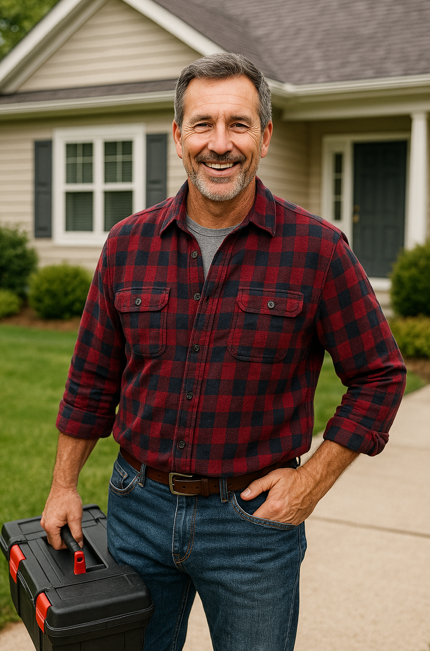👋 Mike Sanders Here: Helping You Stay Warm When It Counts
Hey folks, Mike here. If there’s one question I get every fall from homeowners in colder climates, it’s this: "Which is better for winter, an electric furnace or a heat pump?"
Now, both of these systems have their place. But if you live somewhere that sees real winter—think snow, freezing temps, and icy wind chills—then choosing wrong could mean discomfort, skyrocketing bills, or both.
This article is your no-nonsense guide to what these systems do, how they stack up in a deep freeze, and when it makes sense to go with one over the other.
❄️ What Is an Electric Furnace?
An electric furnace is a simple system: it uses electric resistance coils to create heat. Air passes over the coils, warms up, and gets pushed through your ductwork by a blower motor.
Key Benefits:
-
100% energy conversion (every kilowatt becomes heat)
-
No combustion, no gas lines, no flue pipes
-
Lower maintenance (no burners, no pilot lights)
-
Reliable in any outdoor temperature
Electric furnaces are especially popular in all-electric homes or in regions where natural gas isn’t available or costs too much.
☁️ What Is a Heat Pump?
A heat pump works like a reversible air conditioner. In winter, it pulls heat from the outside air and pumps it into your home. In summer, it does the reverse to cool your home.
Key Benefits:
-
Super efficient (can produce 2 to 3 units of heat for every 1 unit of electricity)
-
Heats and cools with one system
-
Environmentally friendly (especially when paired with R-32 refrigerant or solar)
But here's the catch: efficiency drops as temperatures fall. That’s where things get tricky in colder climates.
⛄️ Heating Performance in Cold Weather
This is where electric furnaces often pull ahead.
| Feature | Electric Furnace | Heat Pump |
|---|---|---|
| Outdoor Temp Impact | None | Efficiency drops below 30°F |
| Backup Heating | Not needed | Often needs electric or gas backup |
| Warmth Feel | Hot air (120°F+) | Cooler air (90-100°F) |
| Reliability | Very high | Moderate (depends on defrost cycles) |
In climates like Minnesota, upstate New York, or Colorado, heat pumps struggle to keep up in January unless they’re cold-climate rated. Even then, you’ll often need electric strip backup to maintain comfort—and that kind of defeats the efficiency advantage.
According to the U.S. Department of Energy, traditional air-source heat pumps start to lose effectiveness below 25°F.
💵 Efficiency and Operating Costs
At first glance, heat pumps look like the winners here. They can be 200-300% efficient, compared to electric furnaces which are 100% efficient.
But here's the key: that efficiency only holds when temps are moderate. In cold climates, a heat pump's coefficient of performance (COP) drops—often down to 1.0 or even less.
Example:
-
Heat pump COP in 50°F weather: 3.0 (300% efficient)
-
Heat pump COP in 10°F weather: 1.2 (120% efficient)
-
Electric furnace COP: 1.0 (100% efficient at all temps)
If you have low electricity rates or solar panels, an electric furnace becomes very cost-competitive.
Check local electricity rates with the U.S. Energy Information Administration.
🌌 Installation and Equipment Costs
Heat pumps have more parts, more refrigerant, and usually cost more to install. But they do give you year-round comfort.
| Item | Electric Furnace | Heat Pump (Air-Source) |
| Equipment Cost | $800 - $2,500 | $2,000 - $5,500 |
| Install Labor | $1,500 - $3,500 | $3,000 - $6,000 |
| Total Cost (avg.) | $3,000 - $6,000 | $5,000 - $11,000 |
Want some local ballpark estimates? Try HomeAdvisor’s heating cost calculator.
🏡 Space, Ductwork, and Maintenance
Electric furnaces are compact, quiet, and straightforward. They slot easily into existing ductwork and require little maintenance besides replacing filters and checking electrical connections.
Heat pumps need both indoor and outdoor units, refrigerant lines, and a condensate drain. That means more install steps and more parts to maintain.
You’ll also want to ensure your ductwork is in good shape. Check out this ENERGY STAR guide on duct sealing.
🌬️ Sustainability and Eco-Friendliness
Heat pumps have a clear edge here:
-
They produce less CO2 than electric furnaces
-
They can use low-GWP refrigerants like R-32
-
They integrate beautifully with solar PV systems
But keep in mind: when a heat pump switches to electric resistance backup, it’s basically running like an electric furnace—at higher cost.
So if you live in a cold region and your pump spends half the winter in backup mode, the green edge starts to fade.
For more, read the NRDC’s report on electrifying home heating.
🚀 Final Verdict: What Mike Recommends
Here’s my honest take:
Go with an electric furnace if:
-
You live in a northern or mountain state with long winters
-
Your home is already all-electric
-
You want rock-solid reliability and low maintenance
-
You have or plan to install solar panels
Go with a heat pump if:
-
You live in a moderate climate (southeast, Pacific coast)
-
You want heating + cooling in one unit
-
Your winters are mild and rarely go below freezing
-
You want to maximize efficiency and reduce emissions
And if you’re somewhere in between? A dual-fuel system (heat pump + electric furnace backup) might be the sweet spot.
🏠 Ready to Choose?
If you’re leaning toward the furnace route, be sure to check out The Furnace Outlet’s selection of electric furnaces. They’ve got quality units, clear specs, and real support if you need help matching one to your home.
No pressure. Just good heat.
Stay warm, stay smart—
Mike Sanders







